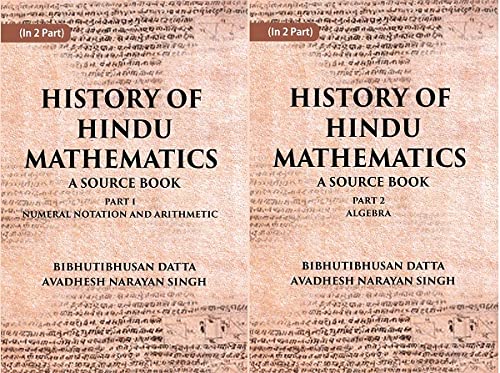HISTORY OF HINDU MATHEMATICS: A SOURCE BOOK (Part- I-NUMERAL NOTATION AND ARITHMETIC, Part- II- ALGEBRA)
HISTORY OF HINDU MATHEMATICS: A SOURCE BOOK (Part- I-NUMERAL NOTATION AND ARITHMETIC, Part- II- ALGEBRA)
Couldn't load pickup availability
About the Book:-History of Hindu Mathematics: A Source Book is a treatise on the history of Indian mathematics. Originally published in two parts in 1930's. Part 1 of the book is divided into chapters. Chapter 1 gives details of the various methods employed by the Hindus for denoting numbers. The chapter also contains details of the gradual evolution of the decimal place value notation in India. Chapter 2 deals with arithmetic in general and it contains the details of various methods for performing the arithmetical operations using a "board". The evolution of the operations of addition, subtraction, multiplication, division, squaring, cubing, and the extraction square root and cube root are all discussed in detail. The whole of Part 2, running to about 307 pages, constitutes just one chapter numbered as Chapter 3 of the book. Some of the topics discussed in this chapter are linear equations with one unknown and with two unknowns, quadratic equations, linear indeterminate equations, solutions of equations of the form Nx2 + 1 = y2, indeterminate equations of higher degrees, and rational triangles. About the Author:- Bibhutibhushan Datta (1888 –1958) was a historian of Indian mathematics. He was a student of Ganesh Prasad, studied at University of Calcutta and secured the master's degree in mathematics in 1914 and doctorate degree in 1920 in applied mathematics. He taught at Calcutta University where he was lecturer at University Science College, and during 1924–1929 he was Rhashbehari Ghosh Professor of Applied Mathematics. During the 1920s and 1930s he created a reputation as an authority on the history of Indian mathematics. He was also deeply interested in Indian philosophy and religion. In 1929 he retired from his professorship and left the university in 1933, and became a sannyasin (an ascetic, a person who has renounced worldly pleasures) in 1938 under the name Swami Vidyaranya.
Share

